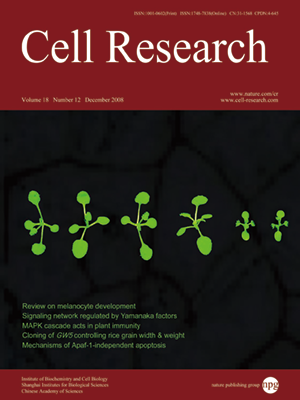
Volume 18, No 12, Dec 2008
ISSN: 1001-0602
EISSN: 1748-7838 2018
impact factor 17.848*
(Clarivate Analytics, 2019)
Volume 18 Issue 12, December 2008: 1210-1219
ORIGINAL ARTICLES
Apaf-1-deficient fog mouse cell apoptosis involves hypo-polarization of the mitochondrial inner membrane, ATP depletion and citrate accumulation
Iyoko Katoh1, Shingo Sato2, Nahoko Fukunishi3, Hiroki Yoshida4, Takasuke Imai5 and Shun-ichi Kurata3
1Department of Microbiology, Interdisciplinary Graduate School of Medicine and Engineering, University of Yamanashi, Yamanashi 409-3898, Japan;
2Department of Immunoregulation, Tokyo Medical and Dental University, 1-5-45 Yushima, Bunkyo-ku 113-8510, Japan;
3Redox Response Cell Biology, Medical Research Institute, Tokyo Medical and Dental University, 1-5-45 Yushima, Bunkyo-ku 113-8510, Japan;
4Department of Biomolecular Sciences, Faculty of Medicine, Saga University, Saga 849-8581, Japan;
5Department of Critical Care Medicine, Tokyo Medical and Dental University, 1-5-45 Yushima, Bunkyo-ku 113-8510, Japan
Correspondence: Shun-ichi Kurata(kushbgen@mri.tmd.ac.jp )
To explore how the intrinsic apoptosis pathway is controlled in the spontaneous
fog (forebrain overgrowth) mutant mice with an Apaf1 splicing deficiency, we examined spleen and bone marrow cells from
Apaf1+/+ (+/+) and
Apaf1fog/fog (
fog/fog) mice for initiator caspase-9 activation by cellular stresses. When the mitochondrial inner membrane potential (Δψm) was disrupted by staurosporine, +/+ cells but not
fog/fog cells activated caspase-9 to cause apoptosis, indicating the lack of apoptosome (apoptosis protease activating factor 1 (Apaf-1)/cytochrome
c/(d)ATP/procaspase-9) function in fog/fog cells. However, when a marginal (~20%) decrease in Δψm was caused by hydrogen peroxide (0.1 mM), peroxynitritedonor 3-morpholinosydnonimine (0.1 mM) and UV-C irradiation (20 J/m
2), both +/+ and
fog/fog cells triggered procaspase-9 auto-processing and its downstream cascade activation. Supporting our previous results, procaspase-9 pre-existing in the mitochondria induced its auto-processing before the cytosolic caspase activation regardless of the genotypes. Cellular ATP concentration significantly decreased under the hypoactive Δψm condition. Furthermore, we detected accumulation of citrate, a kosmotrope known to facilitate procaspase-9 dimerization, probably due to a feedback control of the Krebs cycle by the electron transfer system. Thus, mitochondrial
in situ caspase-9 activation may be caused by the major metabolic reactions in response to physiological stresses, which may represent a mode of Apaf-1-independent apoptosis hypothesized from recent genetic studies.
Cell Research (2008) 18:1210-1219. doi: 10.1038/cr.2008.87; published online 29 July 2008
FULL TEXT | PDF
Browse 1875


